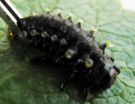(Press-News.org) This release is available in German.
VIDEO:
Chrysomela lapponica: The larva emits toxic secretions, visible as vesicles, from their defensive glands as a chemical protection against predators.
Click here for more information.
Leaf beetles fascinate us because of their amazing variety of shapes and rich coloring. Their larvae, however, are dangerous plant pests. Larvae of the leaf beetle Chrysomela lapponica attack two different tree species: willow and birch. To fend off predator attacks, the beetle larvae produce toxic butyric acid esters or salicylaldehyde, whose precursors they ingest with their leafy food. Scientists of the Max Planck Institute for Chemical Ecology in Jena, Germany, now found that a fundamental change in the genome has emerged in beetles that have specialized on birch: The activity of the salicylaldehyde producing enzyme salicyl alcohol oxidase (SAO) is missing in these populations, whereas it is present in willow feeders. For birch beetles the loss of this enzyme and hereby the loss of salicylaldehyde is advantageous: the enzyme is not needed anymore because its substrate salicyl alcohol is only present in willow leaves, but not in birch. Birch beetles can therefore save resources instead of costly producing the enzyme. First and foremost, however, the loss of salicylaldehyde also means that birch feeding populations do not betray themselves to their own enemies anymore, who can trace them because of the odorous substance. (PNAS Early Edition, DOI 10.1073/pnas.1013846108)
Defensive glands and toxic cocktails
Beetle larvae are part of a food chain. They are attacked by predatory insects and parasites, such as hover flies and bugs, as well as infested by bacteria and fungi. To protect themselves some leaf beetle larvae have developed interesting defense mechanisms, which function externally and metabolically: In case of danger, they emit substances from their defensive glands in form of vesicles (see picture; a short video is also available on http://www.ice.mpg.de/ext/735.html). These defensive secretions contain toxins that the larvae sequester from chemical precursors they have ingested with their plant food. The toxin precursors pass the larva's midgut and reach the defensive glands via a sophisticated molecular transport system. Only a few chemical steps are necessary to produce the actual toxin in the gland.
Dependent on the host plant
Most leaf beetle species only attack one single plant species to feed and reproduce. On the one hand, the uptake of special plant molecules as substrates for toxin-producing enzymes is economical for the beetle larvae; on the other hand, however, the leaf beetles become strongly dependent on the host plant and its specific metabolites. Willows of the Salicaceae family have up to 5 percent glycosylated salicyl alcohol (Salicin) in their leaves, whereas birch trees do not contain these compounds at all. Hence, researchers in the Department of Bioorganic Chemistry of the institute in Jena have investigated how Chrysomela lapponica leaf beetles adapted to both birch and willow as host trees.
First they analyzed in a simple but decisive experiment whether the loss of salicylaldehyde in birch feeders is only due to the fact that the precursor Salicin is not available in birch. To test this they offered willow leaves to hungry leaf beetle larvae they had collected from birch trees. "The beetles were able to ingest Salicin from willow leaves; salicyl alcohol was also detected in their defensive secretions. However, the alcohol was not transformed to an aldehyde; this means that birch feeders lack the enzyme salicyl alcohol oxidase, which is responsible for the oxidation from alcohol to aldehyde," explains Roy Kirsch, who addresses these topics in his PhD project.
Alternative splicing inactivates enzyme in birch feeders
Biochemical analyses revealed that gland secretions of salicylaldehyde producing willow beetles contain the enzyme salicyl alcohol oxidase in strikingly large amounts. The scientists labeled it SAO-W (W: willow). Using corresponding DNA sequence data they isolated and characterized the SAO-B (B: birch) encoding gene from birch feeders. They found that the amino acid sequences of both enzymes are 97 percent identical. However, SAO-B has become inactive because 27 amino acids at the beginning of the polypeptide chain are missing. This was confirmed after heterologous expression in an insect cell culture and subsequent functional tests. Further studies on the defensive glands of birch feeders showed that the amount of messenger RNA (mRNA) of the SAO-B gene was reduced by 1000 times compared to willow beetles; the protein and its enzyme activity were below the detection level. The lack of enzyme activity is caused by a mutation in the SAO-B gene located in the area of the second exon/intron junction. The mutation is responsible for changes in mRNA processing, so-called alternative splicing, which leads to the loss of 27 amino acids in the SAO-B enzyme.
The scientists conclude that, originally, Chrysomela lapponica used willows exclusively as host plants and later shifted to birch trees as well. "It is still unclear, whether the gene mutation has enabled the host plant shift from willow to birch or whether it was adapted in the course of evolution after the shift to birch had occurred," says Wilhelm Boland, the leader of the study. Genetic analysis of further SAO genes from Chrysomela leaf beetle species will allow a better understanding of these processes. [JWK, AO]
INFORMATION:
Original Publication
Kirsch, R., Vogel, H., Muck, A., Reichwald, K., Pasteels, J. M., Boland, W.
Host plant shifts affect a major defense enzyme in Chrysomela lapponica.
Proceedings of the National Academy of Sciences USA, Early Edition, DOI 10.1073/pnas.1013846108.
Further Information:
Prof. Dr. Wilhelm Boland, Max Planck Institute for Chemical Ecology, Hans-Knöll-Straße 8, 07745 Jena. Phone: +49 (0)3641- 57-1200, -1201; e-mail: boland@ice.mpg.de
Pictures:
Download: http://www.ice.mpg.de/ext/735.html
or contact
Angela Overmeyer, Max Planck Institute for Chemical Ecology, Hans-Knöll-Straße 8, 07745 Jena. Phone: +49 (0)3641- 57 2110; e-mail: overmeyer@ice.mpg.de
Host change alters toxic cocktail
Gene modification: Leaf beetle larvae attacking birch trees produce toxic cocktails that differ from the ones produced by conspecifics living on willows
2011-03-13
ELSE PRESS RELEASES FROM THIS DATE:
Choosing a Nursing Home Wrongful Death Lawyer
2011-03-13
Entrusting the life of a loved one to a nursing home can be a difficult transition. No matter how much investigating and pre-checking you perform beforehand, there is always risk and fear involved.
What is Wrongful Death?
Wrongful death is death directly attributable to the fault of another individual or collection of individuals. When your loved one is not provided adequate care or treated with the compassion and respect he or she deserves while a resident in a nursing home, it can be heart wrenching. When that abuse and neglect results in nursing home wrongful ...
Man Sentenced for Sexually Assaulting Children
2011-03-13
Cirilo Cholula Maranchel, 19, of Lakewood, was sentenced to 25 years in prison after pleading guilty to crimes committed in 2009. Maranchel sexually assaulted eight girls, who ranged in age from four to nine. He faced six counts of aggravated sexual assault, as well as two additional sexual assault charges.
Maranchel chose not to try his case, as he wanted to spare his victims the strain that would accompany any trial. However, not everyone charged with a sex offense has such an easy decision. Often, uninformed decisions are made that severely diminish the rights of ...
Around 40 percent of hake is mislabeled
2011-03-13
The DNA studies carried out by a team of Spanish and Greek researchers, and published in the Journal of Agricultural and Food Chemistry, show that more than 30% of the hake products sold in Spain and Greece are wrongly labelled.
"We have found that hake caught in Africa are being labelled as American or European, meaning consumers pay a higher price for them", Eva García Vázquez, a professor at the University of Oviedo (Spain) and co-author of the study, tells SINC.
The researchers analysed 93 packages of fresh hake and several frozen brands in various hypermarkets ...
Co-parenting and Divorce: Keeping Children Secure After Dissolution
2011-03-13
The divorce process provides ample opportunity for frustration and conflict. One spouse may be shocked by the prospect, the other impatient for change, but if children are involved both parents have a duty to keep conversations civil as issues like property division, child custody and visitation get resolved.
As parents start discussing future living arrangements, they should put aside the reasons why the marriage went wrong and make an honest assessment of the children's best interests. They must also realize that those best interests don't stop evolving after the end ...
New technology to predict future appearance
2011-03-13
Montreal, March 11, 2011 – A Concordia graduate student has designed a promising computer program that could serve as a new tool in missing-child investigations and matters of national security. Khoa Luu has developed a more effective computer-based technique to age photographic images of people's faces – an advance that could help to indentify missing kids and criminals on the lam.
"Research into computer-based age estimation and face aging is a relatively young field," says Luu, a PhD candidate from Concordia's Department of Computer Science and Software Engineering ...
Extra iron doesn't help many pregnant women
2011-03-13
Although universal prenatal supplementation with iron is recommended, an extra intake of iron does not noticeably benefit pregnant women, except when they are anemic. This was observed by researchers of the Institute of Tropical Medicine Antwerp and colleagues who followed more than a thousand pregnant women in Burkina Faso.
Our body needs iron to produce hemoglobin, the substance in our red blood cells responsible for the transport of oxygen through our body. In Western countries anemia – a shortage of oxygen transporters – is rare, but in Africa up to half of all women ...
Jarrad's Law: New California Safety Legislation for Young Motorcyclists
2011-03-13
One of the last bills signed by former California Gov. Arnold Schwarzenegger -- with a storied history of motorcycle mishaps himself -- was Jarrad's Law in memory of Sacramento-area teen Jarrad Cole, who died tragically in a summer 2007 motorcycle accident.
On the day that 18-year-old Cole got his new Suzuki motorcycle, his father wanted to create a learning course on their quiet suburban cul-de-sac, so he entered the garage to fetch orange cones. Meanwhile, Cole, who was driving with only a motorcycle learner's permit that he received after passing a written examination, ...
TUM researchers recommend new EU standards for machine strength grading of timber
2011-03-13
This release is available in German.
The natural product wood grows in locations with different climate, soil and environmental conditions. These differences influence its properties as construction material: "Scandinavian spruce, for instance, has smaller knots and lower raw densities than spruce coming from central Europe, and this results in different strength and stiffness values," explains Professor Jan-Willem van de Kuilen from the Department of Wood Technology at TUM. That is why, to ensure the stability of wooden structures, timber must be strength graded before ...
Mount Sinai researcher finds unexpected temperature sensation for a light detector
2011-03-13
New research from Mount Sinai School of Medicine has discovered that rhodopsin, a pigment of the retina that is responsible for the first events in the perception of light, may also be involved in temperature sensation. This detection had not been revealed in previous studies.
The work emerged from a collaboration between the laboratory of Andrew Chess, M.D., Professor in the Departments of Neuroscience, Developmental and Regenerative Biology and Genetics and Genomic Sciences at Mount Sinai, and the laboratory of Craig Montell, Ph.D., Professor of Biological Chemistry ...
Distracted Driving Causes Fatal Pennsylvania Car Accident
2011-03-13
The United States Department of Transportation says that almost 5,500 people died and half a million were injured in 2009 in crashes involving distracted drivers. A recent accident on Interstate 81 in Pennsylvania brings new life to these staggering statistics.
A dump truck carrying 24 tons of rock salt crashed caused a five-vehicle crash in the Susquehanna township. State police believe the truck driver was distracted, although they have not yet said how. Police investigating the fatal truck accident said that the truck driver never slowed when approaching stopped traffic ...
LAST 30 PRESS RELEASES:
Many mothers in Norway do not show up for postnatal check-ups
Researchers want to find out why quick clay is so unstable
Superradiant spins show teamwork at the quantum scale
Cleveland Clinic Research links tumor bacteria to immunotherapy resistance in head and neck cancer
First Editorial of 2026: Resisting AI slop
Joint ground- and space-based observations reveal Saturn-mass rogue planet
Inheritable genetic variant offers protection against blood cancer risk and progression
Pigs settled Pacific islands alongside early human voyagers
A Coral reef’s daily pulse reshapes microbes in surrounding waters
EAST Tokamak experiments exceed plasma density limit, offering new approach to fusion ignition
Groundbreaking discovery reveals Africa’s oldest cremation pyre and complex ritual practices
First breathing ‘lung-on-chip’ developed using genetically identical cells
How people moved pigs across the Pacific
Interaction of climate change and human activity and its impact on plant diversity in Qinghai-Tibet plateau
From addressing uncertainty to national strategy: an interpretation of Professor Lim Siong Guan’s views
Clinical trials on AI language model use in digestive healthcare
Scientists improve robotic visual–inertial trajectory localization accuracy using cross-modal interaction and selection techniques
Correlation between cancer cachexia and immune-related adverse events in HCC
Human adipose tissue: a new source for functional organoids
Metro lines double as freight highways during off-peak hours, Beijing study shows
Biomedical functions and applications of nanomaterials in tumor diagnosis and treatment: perspectives from ophthalmic oncology
3D imaging unveils how passivation improves perovskite solar cell performance
Enriching framework Al sites in 8-membered rings of Cu-SSZ-39 zeolite to enhance low-temperature ammonia selective catalytic reduction performance
AI-powered RNA drug development: a new frontier in therapeutics
Decoupling the HOR enhancement on PtRu: Dynamically matching interfacial water to reaction coordinates
Sulfur isn’t poisonous when it synergistically acts with phosphine in olefins hydroformylation
URI researchers uncover molecular mechanisms behind speciation in corals
Chitin based carbon aerogel offers a cleaner way to store thermal energy
Tracing hidden sources of nitrate pollution in rapidly changing rural urban landscapes
Viruses on plastic pollution may quietly accelerate the spread of antibiotic resistance
[Press-News.org] Host change alters toxic cocktailGene modification: Leaf beetle larvae attacking birch trees produce toxic cocktails that differ from the ones produced by conspecifics living on willows


